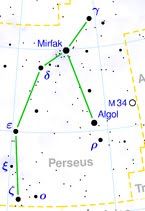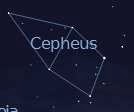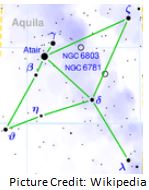The DC Women's Hiking Group will hike at Sturges Park in Ridgefield on Thurs. Dec. 12th.
Take West Mountain Rd. follow to Oreneca Rd. at intersection take Rippowam
Rd.
Follow Rippowan .4 miles to parking lot.
Meet at 8:30am.
Thursday, December 12, 2013
Friday, December 6, 2013
December 2013 Constellation of the Month: Perseus
Last month's constellation,
Cassiopeia - the "W", is almost directly overhead around 7 PM. If you
look slightly south and east of this W, you'll find Perseus. It is shaped like
a wishbone which points at Cassiopeia. The band of the Milky Way runs from
Cassiopeia through Perseus. (See last month's Constellation of the Month post
on this blog for more on the band of the Milky Way).
Perseus's brightest star, Algol,
is actually 3 stars. Two revolve around each other (actually around a point in
between them) and the 3rd moves along a large elliptical path outside the other
two. More than half the stars in our Milky Way galaxy are multiple stars
-- doubles, triples, sextuples, etc.
Algol is also a variable star
-- which are much less common than multiple stars. About every 3 days, Algol's
brightness drops by about 70%. This occurs when the larger, but fainter, star
passes in front (as viewed from the Earth) of the brighter star. In addition to
eclipsing variables like Algol, other variable stars are caused by pulsing -- a
star actually expands and shrinks periodically. The brightness of some variable
stars can vary by a factor or 1,000 or more in a period of less than a year.
Perseus is also home to M 34 --
an open cluster of about 400 stars, which is easily seen with binoculars. An open
cluster is a group of stars which were formed from the same nebula
(huge cloud of gasses) at roughly the same time -- about 200 million years ago
for M34. This is very young as stars go; the Sun is about 5 billion years old.
M34 appears to cover an area in the sky about the size of the full moon. It's
about 7 light years across, and about 1,500 light years away. A light year
is about 6 trillion miles, which is the distance light travels in one year. So,
when you're looking at this cluster, you're actually seeing it as it was 1,500
years ago.
Monday, December 2, 2013
Friday, November 22, 2013
The DC Women's Hiking Group will hike Tues., Nov. 26th at Topstone Park in Redding, CT.
Take Topstone Rd. off of Rt. 7.
Follow road over RR tracks until it becomes a dirt road.
Shortly after, a parking area will be on the right side of the road.
Meet at 8:30am.
No hike on Thursday, November 28th.
Have a Happy Thanksgiving!
Take Topstone Rd. off of Rt. 7.
Follow road over RR tracks until it becomes a dirt road.
Shortly after, a parking area will be on the right side of the road.
Meet at 8:30am.
No hike on Thursday, November 28th.
Have a Happy Thanksgiving!
Monday, November 18, 2013
Sunday, November 3, 2013
Constellation
of the Month - Cassiopeia, the "W"
Cassiopeia
is a "W"- shaped constellation. It's high in the sky towards the East soon
after sunset in November.
Cassiopeia is an interesting constellation for
several reasons:
1. It's Circumpolar:
It's one of a few constellations that never rise and never set – for viewers in
earth's Northern Hemisphere. They just (appear to) go in circles around the
North Star -- every day a circle, and every year a much slower circle. At 6AM it will be low in the sky to the north, and 6 months from now in the
evening, it will be about the same place.
If you lived at the North Pole, all the stars you could see
would be circumpolar. But they'd only be half the stars in the sky, because the
other half -- which you would never see -- would be circumpolar for those
penguins looking up from the South Pole.
2. It's always opposite the Big Dipper, with the North Star about midway between them. So, if you
look north from Cassiopeia, and keep going north and lower in the sky, you'll
find the Big Dipper low in the north. 3 months ago and 3 months from now, they
were and will be opposite each other east to west.
3. The band of the Milky Way goes through it. We're in the Milky Way galaxy, which is shaped like a
disk. When we see it as a fuzzy band of many, many stars, we're looking along
the plane of the disk, so we see what looks like a band of stars. When we look
anywhere except along this plane we just see a few stars that are close, and
that's what the rest of the sky (outside the band) looks like.
In ancient mythology, Cassiopeia is the Queen to King
Cepheus, our October 2013 constellation of the month.
The DC Women's Hiking Group will hike Thursday, Nov. 7th at Florida Refuge in Ridgefield.
There is no school on Tuesday the 5th, so no hike.
Take Rt. 7 and turn onto Florida Hill Road. Make a right onto High Valley Road.
Park along the side of High Valley Road closest to Florida Hill Road.
Meet at 8:30am.
There is no school on Tuesday the 5th, so no hike.
Take Rt. 7 and turn onto Florida Hill Road. Make a right onto High Valley Road.
Park along the side of High Valley Road closest to Florida Hill Road.
Meet at 8:30am.
Sunday, October 27, 2013
The DC Womens Hiking Group will meet at Lewisboro Park in NY this week, Tues., Oct. 29th and Thurs., Oct. 31st.
Located on the south side of Rt. 35 between Mead Street and Bouton Road in South Salem.
Turn at white sign for Lewisboro Park off of Rt. 35 and follow up hill to upper parking area.
Meet at 8:30am.
Located on the south side of Rt. 35 between Mead Street and Bouton Road in South Salem.
Turn at white sign for Lewisboro Park off of Rt. 35 and follow up hill to upper parking area.
Meet at 8:30am.
Monday, October 21, 2013
Friday, October 11, 2013
The DC Women's Hiking Group will hike Tues., Oct. 15th and Thurs., Oct. 17th at Bear Mountain Reservation in CT.
Take exit 5 off of I-84. Follow Rt. 37 North past all the shopping centers. Go past the
commercialized district and eventually past the federal prison into the more
rural part of northern Danbury. About 0.2 mile past the prison entrance, on
the right, is Bear Mountain Road which is 2.8 miles from I-84. Turn right
onto Bear Mountain Road and follow it for 0.5 mile. Turn right into the
entrance of Bear Mountain Reservation.
Meet at 8:30am.
commercialized district and eventually past the federal prison into the more
rural part of northern Danbury. About 0.2 mile past the prison entrance, on
the right, is Bear Mountain Road which is 2.8 miles from I-84. Turn right
onto Bear Mountain Road and follow it for 0.5 mile. Turn right into the
entrance of Bear Mountain Reservation.
Monday, October 7, 2013
October 2013 Constellation of the Month – Cepheus
Cepheus is somewhat fainter than better-known constellations. But, it is easy to find, since parts of several prominent constellations point to it. It is between Cassiopeia, "the W", and Cygnus, the Northern Cross. The easternmost leg of the W and the head of the Cross both point to it. If you extended northward the lines which form the east and west sides of Pegasus's "square" they would intersect in Cepheus.
Some people think of Cepheus as a pentagon, others say it looks like a house a child might draw. In Greek mythology, Cepheus was the king of Ethiopia. His wife, the queen, was Cassiopeia. His daughter was Andromeda, whose constellation extends out from the northeast star in the square of Pegasus.
Cepheus is a circumpolar constellation for observers in the northern hemisphere. That means it is positioned close enough the North Star (which it appears to circle daily and yearly) so that it never sets..
Delta Cephei is a very famous and important star. It more than doubles its brightness, and fades back, over a regular period of 3 days, 5 hours, 37 minutes. Its name is used for a whole class of pulsating variable stars which behave similarly. If one knows the length of the period over which a Cepheid variable star varies, one can calculate its luminosity. Luminosity is the absolute brightness of a star – how bright it would appear if all stars were at the same distance from the observer. Using these calculations, about 100 years ago, astronomers found that the distance of one Cepheid variable in the Andromeda galaxy was about 3 million light years away. So it confirmed the Andromeda group of stars was far outside our Milky Way galaxy, and was itself a galaxy. Since then, it has been regularly used to calculate distances to star clusters and galaxies.
Another famous variable star in Cepheus is Mu Cephei, known as the Garnet Star, because of its striking red color
Monday, September 30, 2013
The DC Women's Hiking Group will hike this week, Oct. 1st and Oct. 3rd at Tarrywille Park in Danbury.
From I-84 take the airport exit.
At end of ramp turn right.
Follow through traffic lights and at stop sign turn onto Southern Blvd. ( It will be a sharp right turn).
Follow small brown signs for Tarrywile Park.
The park will be on the right, across from Immaculate H.S.
Meet in lower parking lot at 8:30am.
From I-84 take the airport exit.
At end of ramp turn right.
Follow through traffic lights and at stop sign turn onto Southern Blvd. ( It will be a sharp right turn).
Follow small brown signs for Tarrywile Park.
The park will be on the right, across from Immaculate H.S.
Meet in lower parking lot at 8:30am.
Monday, September 23, 2013
The DC Women's Hiking Group will hike Tues., Sept.,24th and Thurs., Sept., 26th at Scott Lot Preserve in Redding, CT.
Coming from the north on Route 7 turn left onto Old Redding Rd. Right after going under RR bear right onto Mountain Rd. Follow Mountain Rd. to end and turn left onto Peaceable St. Parking for the open space will be on the left. If you come to an electrical substation, you went too far.
Meet at 8:30am.
Saturday, September 14, 2013
The DC Women's Hiking Group will hike Tues., Sept. 17th and Thurs., Sept. 19th at Lake Windwing in Ridgefield.
From Rt. 35 going towards Rt. 7, turn left onto Limestone Rd. at traffic light.
Follow road as it turns into Bennett's Farm Rd.
Across from Ridgebury Elementary School, turn right on to South Shore Drive.
Follow road to parking area on left.
Meet at 8:30am.
From Rt. 35 going towards Rt. 7, turn left onto Limestone Rd. at traffic light.
Follow road as it turns into Bennett's Farm Rd.
Across from Ridgebury Elementary School, turn right on to South Shore Drive.
Follow road to parking area on left.
Meet at 8:30am.
Sunday, September 8, 2013
Monday, September 2, 2013
The DC Women's Hiking Group will hike Tues., Sept. 3rd at Topstone Park in Redding, CT.
Take Topstone Rd. off of Rt. 7.
Follow road over RR tracks until it becomes a dirt road.
Shortly after, a parking area will be on the right side of the road.
Meet at 8:30am.
NOTE: No hike on Thurs., Sept. 5th due to No School.
Take Topstone Rd. off of Rt. 7.
Follow road over RR tracks until it becomes a dirt road.
Shortly after, a parking area will be on the right side of the road.
Meet at 8:30am.
NOTE: No hike on Thurs., Sept. 5th due to No School.
Sunday, September 1, 2013
2013 09 Constellation of the Month – Aquila
Aquila, the Eagle is a fairly easy constellation to
identify. Along with last month's constellation
of the month, Lyra, and the October 2012 constellation of the month, Cygnus,
Aquila's brightest star, Altair makes up the large and prominent Summer Triangle of stars. Aquila is the southernmost of these three constellations.
Aquila's immediate neighbors are small and rather faint constellations, such as Delphinus, Scutum, Vulpecula, Sagitta, Capricornus, and Equuleus. The tail of Serpens points to Aquila from the East.
The band
of the Milky Way passes through Aquila on the way from Cygnus
to the North and Sagittarius
to the South. When we look at the band
of the Milky Way, we are looking along the plane of our disc-shaped
galaxy. As a result, we see many more
starts than if we look above or below the plane. We would also expect there to be many more nebulae
and star clusters, but those in the line of sight of Aquila are relatively
faint.
Coincidentally, there are very few galaxies to be
found looking in the direction of Aquila.
So, there are no Messier objects in Aquila. The French astronomer Charles Messier
cataloged a list of 110 hazy objects in the sky. He was trying to identify these objects -- which appeared to stay in the same place -- in order to distinguish them from moving comets, for which he was
searching. The objects he cataloged turned
out to be nebulae (clouds of gases) in our galaxy and distant galaxies themselves. But nothing in
Aquila makes this Top 110.
Wednesday, August 28, 2013
Seth Low Pierrepont - Women's Hiking Group start 2013
This year the Women's Hiking group will start its weekly hikes at Seth
Low Pierrepont State Park. But who was Seth Low Pierrepont? He was a
millionaire and ex-diplomat who served as a US official in Italy, France
and Chile. He was also chief of the American Division of the US State
Department. In the early 1930's he purchased this large tract of land
from the Scott family and made it into his estate. Upon his death in
1956, he gifted it to the CT State Park & Forest Commission. Its 313
acres contains trails with views, Lake Naraneka (Pierrepont Pond) and
history.
The Scott family has a long history in Ridgefield. David Scott was one of the original Proprietors and purchased lot 13 on June 3, 1712. The family included a number of Ridgefield patriots, tanners, millers and of course farmers. When Rana Scott married John Barlow Jr. in 1789, this area was already referred to as the Scotland District and was a thriving community. It is the old foundation of the Scott house dating from 1720's that can be seen at the boat launch. Hints of their farming life can be seen in the stonewalls throughout the park and the cellar holes on the northern end of the park. One of these cellar holes was John Barlow's blacksmith shop. What is now Old Barlow Mountain Road was a main thoroughfare into town. General Wooster led his troops along it on his way to meet the British Army in what was to become The Battle of Ridgefield. Scotland & Barlow Mountain Elementary Schools along with Scott's Ridge Middle School bear the legacy of this family.
(This post first appeared on Sept 27, 2010 & Sept 5, 2011
The Scott family has a long history in Ridgefield. David Scott was one of the original Proprietors and purchased lot 13 on June 3, 1712. The family included a number of Ridgefield patriots, tanners, millers and of course farmers. When Rana Scott married John Barlow Jr. in 1789, this area was already referred to as the Scotland District and was a thriving community. It is the old foundation of the Scott house dating from 1720's that can be seen at the boat launch. Hints of their farming life can be seen in the stonewalls throughout the park and the cellar holes on the northern end of the park. One of these cellar holes was John Barlow's blacksmith shop. What is now Old Barlow Mountain Road was a main thoroughfare into town. General Wooster led his troops along it on his way to meet the British Army in what was to become The Battle of Ridgefield. Scotland & Barlow Mountain Elementary Schools along with Scott's Ridge Middle School bear the legacy of this family.
(This post first appeared on Sept 27, 2010 & Sept 5, 2011
Tuesday, August 27, 2013
As school starts up, it's time to get hiking again.
The DC Women's Hiking Group will start up for the season on Thurs., Aug. 29th.
We will hike at Seth Low Pierrepont State Park in Ridgefield.
The park is located on Barlow Mt. Rd. across from Scotland and Barlow Mt. Elementary Schools.
Meet in the parking area at 8:30am.
The DC Women's Hiking Group will start up for the season on Thurs., Aug. 29th.
We will hike at Seth Low Pierrepont State Park in Ridgefield.
The park is located on Barlow Mt. Rd. across from Scotland and Barlow Mt. Elementary Schools.
Meet in the parking area at 8:30am.
Tuesday, August 20, 2013
Blue Moon of August 2013
Blue Moon Rises Tonight: 5 Amazing Facts
by Miriam Kramer, Staff Writer | August 20, 2013 10:58am
ET from Space.com
When the full moon rises tonight (Aug. 20), it will
technically be a Blue Moon, but not for the reason you might think.
The Blue Moon tonight is not
the second full moon of August, but actually gets its name from a relatively
obscure rule of astronomy. And there are a few other details about the full
moon that might surprise you.
So to celebrate the Blue Moon, here are five amazing facts about
this month's full moon:
1) It is not really blue: Okay,
so not really a newsflash, but the Blue Moon's name actually has nothing to do
with color. Occasionally, the full moon can take on a reddish pallor, but
today's full moon is not related to the actual color of Earth's cosmic
neighbor. The moon can appear blue in color if a forest fire or volcanic
eruption litters the upper atmosphere with ash or smoke. A volcanic eruption
gave the moon a bluish tint from the perspective of many people on Earth in
1991.
2) There are two definitions for Blue Moon: The
term Blue Moon was originally assigned to the third full moon in a four moon
season, but after a mix up in "Sky & Telescope" magazine in 1943,
the term took on a different meaning. An article in the magazine incorrectly
defined a blue moon as the second full moon in a single month, but the
definition stuck. This particular blue moon is a technical Blue Moon, but does
not meet the criteria for the second definition. The third full moon in a
four-full-moon season rule was detailed in a 1937 edition of the now defunct
Maine Farmers' Almanac.
3) The Blue Moon has many names:
Today's full moon is also known as the Full Sturgeon Moon, the Green Corn Moon,
the Grain Moon, and the Full Red Moon. Each of the August full moon names come from monikers given to the full
moons of a certain month according to Native American and European traditions.
4) It is only full for a moment:
Although the moon usually looks full one day before and one day after the day
of the full moon, there is technically only one moment when the moon is full in
the sky. Tonight, the moon turns full at 9:45 p.m. EDT (0145 Aug. 21 GMT), when
(weather and light permitting) the moon will be in view for people along the
eastern coast of the United States.
5) It is kind of a rare sight: Blue
Moons occur somewhat infrequently. After today's full moon, another Blue
Moon will not occur again until 2015. The idiom "once in a Blue Moon"
signifies a rare event because scientists had trouble predicting when the
distinctive full moon would happen during any given year.
By Miriam Kramer. Original article on SPACE.com.
Subscribe to:
Posts (Atom)








